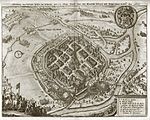Plzeň
Cities and towns in the Czech RepublicPlzeňPopulated places in Plzeň-City District

Plzeň (Czech pronunciation: [ˈpl̩zɛɲ] (listen); German and English: Pilsen, in German pronounced [ˈpɪlzn̩] (listen)) is a city in the Czech Republic. About 90 kilometres (56 miles) west of Prague in western Bohemia, it is the fourth most populous city in the Czech Republic with about 181,000 inhabitants. The city is known worldwide for Pilsner beer, created by Bavarian brewer Josef Groll in the city in 1842.
Excerpt from the Wikipedia article Plzeň (License: CC BY-SA 3.0, Authors, Images).Plzeň
náměstí Republiky, Pilsen Vnitřní Město
Geographical coordinates (GPS) Address Nearby Places Show on map
Geographical coordinates (GPS)
| Latitude | Longitude |
|---|---|
| N 49.7475 ° | E 13.3775 ° |
Address
svatý Bartoloměj
náměstí Republiky
301 37 Pilsen, Vnitřní Město
Southwest, Czechia
Open on Google Maps










